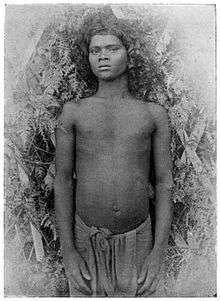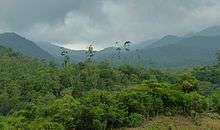Paniya people
The Paniya, also known as Paniyar and Paniyan, are an ethnic group of India. They primarily inhabit Kerala, and the Wayanad, Kozhikode, Kannur and Malappuram districts. The Paniya speak the Paniya language, which belongs to the Dravidian family. A scheduled tribe, they have a population of around 94,000 individuals.
 A Paniya man (1909). | |
| Total population | |
|---|---|
| 94,000 | |
| Regions with significant populations | |
| Kerala | 88,450 |
| Tamil Nadu | 10,134 |
| Languages | |
| Paniya language | |
| Religion | |
| Hinduism, traditional religion, Christianity | |
| Related ethnic groups | |
| Tamil Malayali | |
History

The Paniya have historically worked as agricultural labourers. They are believed to have been brought to Wayanad by the king of Malabar, and thereafter tilled the land as serfs. Following the abolishment of the slave-holding system, the Paniya were resettled in different areas established by the government.[1]
Paniyas were also historically reputed for their boldness and recklessness. For this reason, they were often employed as thieves.[2]
The Paniya today are a scheduled tribe.[3] One particular sub-group of theirs, the Kattupaniyar, inhabits the forest region of Nilambur in the Malappuram District. Here, members lead a traditional hunter-gatherer lifestyle.[1]
Demographics
The Paniya mainly inhabit Kerala, and the Wayanad, Kozhikode, Kannur and Malappuram districts of India. Others reside in Tamil Nadu, the area west of the Nilgiris hills, as well as the Kodagu District of Karnataka.[3]
Paniyas have a total population of around 94,000 individuals (2003).[3] Of those, around 67,948 live in the Kerala hills.[1]
Language
The Paniya speak the Paniya language as a mother tongue. A member of the Dravidian family, it is most closely related to Malayalam, Kadar, Ravula and other Dravidian languages.[3]
Paniya is spoken both at home and during religious ceremonies. Some Paniyas also use other Dravidian languages such as Malayalam, Tamil or Kannada.[3]
Paniyas use different writing systems depending on where in India they reside. Those in Karnataka use the Kannada script, those in Kerala write in the Malayalam script, while the Paniya in Tamil Nadu use the Tamil script.[3]
Culture

Paniyas typically live in villages (padis) consisting of a few huts (pire or chala) with courtyards. Each hut settlement contains 5 to 15 families.[4]
For attire, Paniya males wear a lengthy cloth wrapped around the waist, which is known as a mundu. A smaller mundu is also slung over the shoulders to cover the body. Paniya females or panichi don a long cloth, with a smaller one above the breast area and around the armpits. In addition, they wear a red or black aratti scarf around the waist.[4]
The Paniyas bury their dead in formal funeral rites. Typically, the place of burial is close to the padi. The interment is accompanied by a seven-day mourning period by family members.[4]
Religion
The modern Paniya practice a variety of faiths. Among these are Hinduism, traditional religion, and Christianity.[3]
Genetics
A study by Yelmen et al (2019) identified the Paniya alongside the Irulas, as the best fit proxy for the Ancient Anscestral South Indian (AASI), one of the founder indigenous populations of South Asia.[5]
See also
- Irulas
- Soliga tribe
References
- "Major Tribals in Kerala". FocusonPeople. Retrieved 6 November 2013.
- Keane, A. H. "Man, Past and Present". Cambridge University Press. Retrieved 10 November 2013.
- "Paniya: A Language of India". Ethnologue. Retrieved 6 November 2013.
- Varghese, T. "Socio-Economic Profile of Paniya Tribe" (PDF). Shodhganga. Retrieved 9 November 2013.
- Yelmen, Burack; Mondal, Mayukh; Marnetto, David; Pathak, Ajay; Montinaro, Francesco; Romero, Irene; Kivisild, Toomas; Metspalu, Mait; Pagani, Luca (5 April 2019). "Demographic Histories and Opposite Selective Pressures in Modern South Asian Populations". Cite journal requires
|journal=(help)